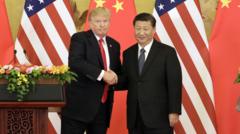Despite years of escalating tariffs and heated exchanges, top trade officials from the United States and China are set to meet this Saturday in Switzerland for the first significant discussions since the trade war intensified earlier this year. The meeting comes at a time when the economic impacts of the tariffs—145% on Chinese imports and up to 125% on some US exports—are being increasingly felt on both sides.
Recent communications from officials indicate a potential shift in strategy, wherein both nations are eager to avoid being perceived as the ones to concede. “Neither side wants to show weakness,” notes Stephen Olson, a trade expert at the ISEAS-Yusof Ishak Institute, reinforcing that the current environment is ripe for negotiations, even if both parties are keeping up a façade of strength.
Chinese officials have insisted that the US is the one requesting these discussions, framing their participation as a responsive measure to US business interests. Conversely, the Trump administration argues that it is the Chinese side that seeks dialogue out of desperation due to a faltering economy—a claim he emphasized at a recent press conference.
Adding to the context, President Xi Jinping is currently in Moscow, enhancing China's global positioning while approaching these talks. His participation at the Victory Day parade underscores China's alternative alliances, subtly reminding the US that it has options beyond solely engaging with America.
While both nations project strength, the domestic economic realities tell a different story. China’s manufacturing sector is facing challenges, with production levels dropping sharply, and US industries reliant on Chinese goods are reporting disruptions. The uncertainties created by tariffs have already led to a contraction in the US economy—the first in three years—a situation that has only added pressure on Trump, whose ratings are wavering amidst concerns over inflation.
Experts do express optimism regarding the talks, although full resolutions may take time. “These initial meetings will primarily establish communication and lay the groundwork for future negotiations,” Hofman explained. It mirrors previous attempts during Trump's first term, which initially led to a “phase one” agreement, albeit leaving many critical issues unaddressed.
While immediate breakthroughs may be elusive, some analysts predict a potentially enhanced deal that addresses deeper systemic issues in the relationship, including key negotiations around supply chains and governance. However, hurdles remain, with current sentiments indicating that substantial progress won’t come swiftly.
As the discussions approach, observers are left contemplating whether these talks will serve as a turning point in trade relations or merely a temporary pause in a long-standing economic battle.
Recent communications from officials indicate a potential shift in strategy, wherein both nations are eager to avoid being perceived as the ones to concede. “Neither side wants to show weakness,” notes Stephen Olson, a trade expert at the ISEAS-Yusof Ishak Institute, reinforcing that the current environment is ripe for negotiations, even if both parties are keeping up a façade of strength.
Chinese officials have insisted that the US is the one requesting these discussions, framing their participation as a responsive measure to US business interests. Conversely, the Trump administration argues that it is the Chinese side that seeks dialogue out of desperation due to a faltering economy—a claim he emphasized at a recent press conference.
Adding to the context, President Xi Jinping is currently in Moscow, enhancing China's global positioning while approaching these talks. His participation at the Victory Day parade underscores China's alternative alliances, subtly reminding the US that it has options beyond solely engaging with America.
While both nations project strength, the domestic economic realities tell a different story. China’s manufacturing sector is facing challenges, with production levels dropping sharply, and US industries reliant on Chinese goods are reporting disruptions. The uncertainties created by tariffs have already led to a contraction in the US economy—the first in three years—a situation that has only added pressure on Trump, whose ratings are wavering amidst concerns over inflation.
Experts do express optimism regarding the talks, although full resolutions may take time. “These initial meetings will primarily establish communication and lay the groundwork for future negotiations,” Hofman explained. It mirrors previous attempts during Trump's first term, which initially led to a “phase one” agreement, albeit leaving many critical issues unaddressed.
While immediate breakthroughs may be elusive, some analysts predict a potentially enhanced deal that addresses deeper systemic issues in the relationship, including key negotiations around supply chains and governance. However, hurdles remain, with current sentiments indicating that substantial progress won’t come swiftly.
As the discussions approach, observers are left contemplating whether these talks will serve as a turning point in trade relations or merely a temporary pause in a long-standing economic battle.






















